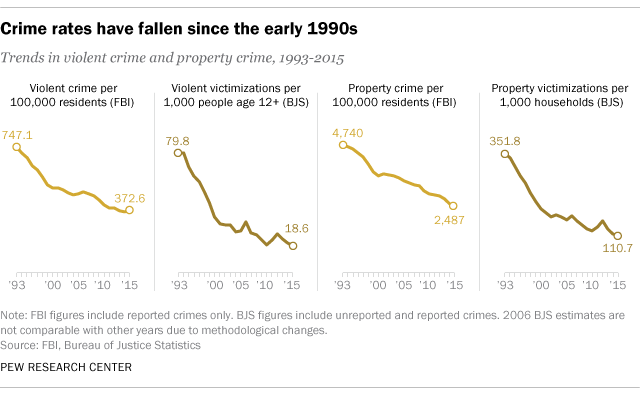Americans are often wrong about crime. Here's why

Public perceptions about crime often don't align with statistics.
Image: REUTERS/Keith Bedford
Stay up to date:
Cities and Urbanization

Donald Trump made crime-fighting an important focus of his campaign for president, and he cited it again during his inaugural address in January. With the White House and Justice Department announcing steps to address violence in American communities, here are five facts about crime in the United States.
1. Violent crime in the U.S. has fallen sharply over the past quarter century. There are two commonly cited measures of the nation’s crime rate. One is an annual report by the FBI of serious crimes reported to police in approximately 18,000 jurisdictions around the country. The other is an annual survey of more than 90,000 households conducted by the Bureau of Justice Statistics, which asks Americans ages 12 and older whether they were the victims of crime in the past six months (regardless of whether they reported those crimes to the police or not). Both the FBI and BJS data show a substantial decline in the violent crime rate since its peak in the early 1990s.
Using the FBI numbers, the rate fell 50% between 1993 and 2015, the most recent full year available. Using the BJS data, the rate fell by 77% during that span. It’s important to note, however, that the FBI reported a 3% increase in the violent crime rate between 2014 and 2015, including a 10% increase in the murder rate. (The BJS figures show a stable violent crime rate between 2014 and 2015, but they do not count murders.) Some experts have projected that the 2016 FBI data will show another increase in the violent crime rate – including another rise in the murder rate – when they are released later this year.
2. Property crime has declined significantly over the long term. Like the violent crime rate, the U.S. property crime rate today is far below its peak level. FBI data show that the rate fell 48% between 1993 and 2015, while BJS reports a decline of 69% during that span. Both the FBI and BJS reported a decline in the property crime rate between 2014 and 2015, even as the violent crime rate went up in the FBI’s data. Property crime includes offenses such as burglary, theft and motor vehicle theft and is generally far more common than violent crime.
3. Public perceptions about crime in the U.S. often don’t align with the data. Opinion surveys regularly find that Americans believe crime is up, even when the data show it is down. In 21 Gallup surveys conducted since 1989, a majority of Americans said there was more crime in the U.S. compared with the year before, despite the generally downward trend in both violent and property crime rates during much of that period. In a Pew Research Center survey in late 2016, 57% of registered voters said crime had gotten worse since 2008, even though BJS and FBI data show that violent and property crime rates declined by double-digit percentages during that span.

4. There are large geographic variations in crime rates. The FBI’s data allow for geographic comparisons of crime rates, and these comparisons can show big differences from state to state and city to city. In 2015, for instance, there were more than 600 violent crimes per 100,000 residents in Alaska, Nevada, New Mexico and Tennessee. By contrast, Maine, New Hampshire, Vermont and Virginia had rates below 200 violent crimes per 100,000 residents. And while Chicago has drawn widespread attention for its soaring murder total in recent years, its murder rate in 2015 – 18 murders and non-negligent manslaughters per 100,000 residents – was less than a third of the rate in St. Louis (59 per 100,000) and Baltimore (55 per 100,000). The FBI notes that various factors might influence a particular area’s crime rate, including its population density and economic conditions.
5. Many crimes are not reported to police. In its annual survey, BJS asks victims of crime whether or not they reported that crime to police. In 2015, the most recent year available, only about half of the violent crime tracked by BJS (47%) was reported to police. And in the much more common category of property crime, only about a third (35%) was reported. The proportion was substantially higher for offenses classified as serious violent crime (55%), a category that includes serious domestic violence (61% of which was reported), serious violent crime involving injury (59%) and serious violent crime involving weapons (56%). There are a variety of reasons why crime might not be reported, including a feeling that police “would not or could not do anything to help” or that the crime is “a personal issue or too trivial to report,” according to BJS.
Don't miss any update on this topic
Create a free account and access your personalized content collection with our latest publications and analyses.
License and Republishing
World Economic Forum articles may be republished in accordance with the Creative Commons Attribution-NonCommercial-NoDerivatives 4.0 International Public License, and in accordance with our Terms of Use.
The views expressed in this article are those of the author alone and not the World Economic Forum.
Forum Stories newsletter
Bringing you weekly curated insights and analysis on the global issues that matter.
More on Emerging TechnologiesSee all
Manfred Elsig and Rodrigo Polanco Lazo
April 23, 2025
Michael Siegel
April 23, 2025
Khalid Alaamer
April 22, 2025
Gustavo Maia
April 22, 2025
Cathy Hackl
April 21, 2025
Aimée Dushime
April 18, 2025





